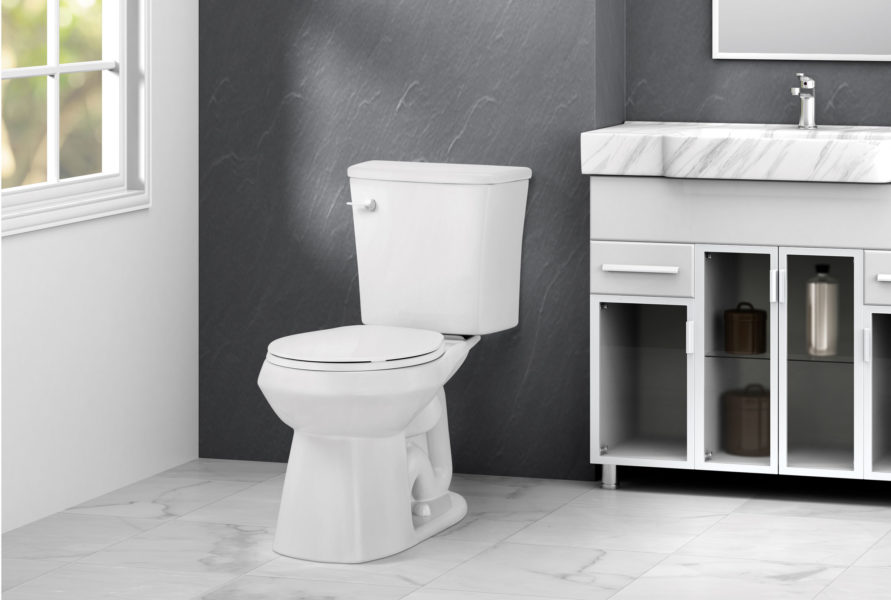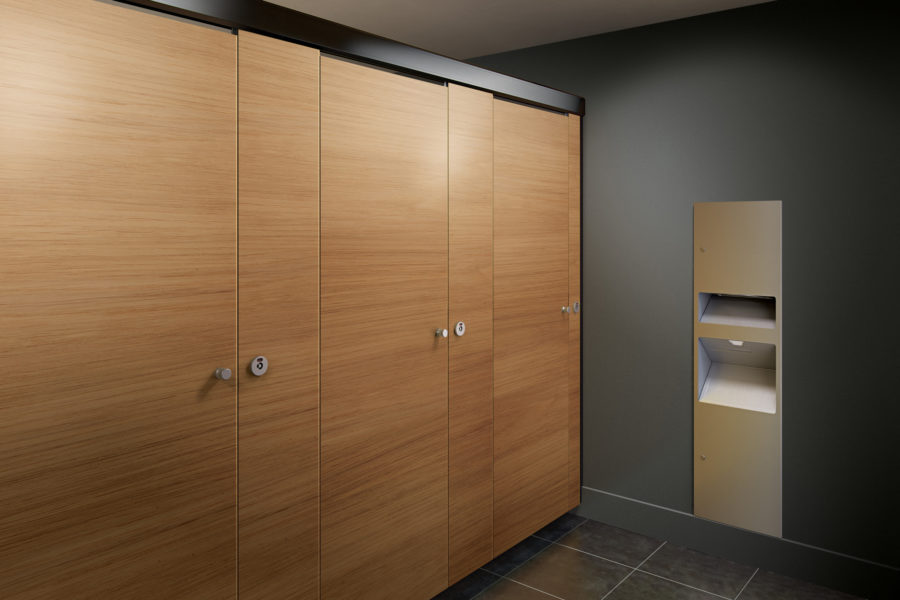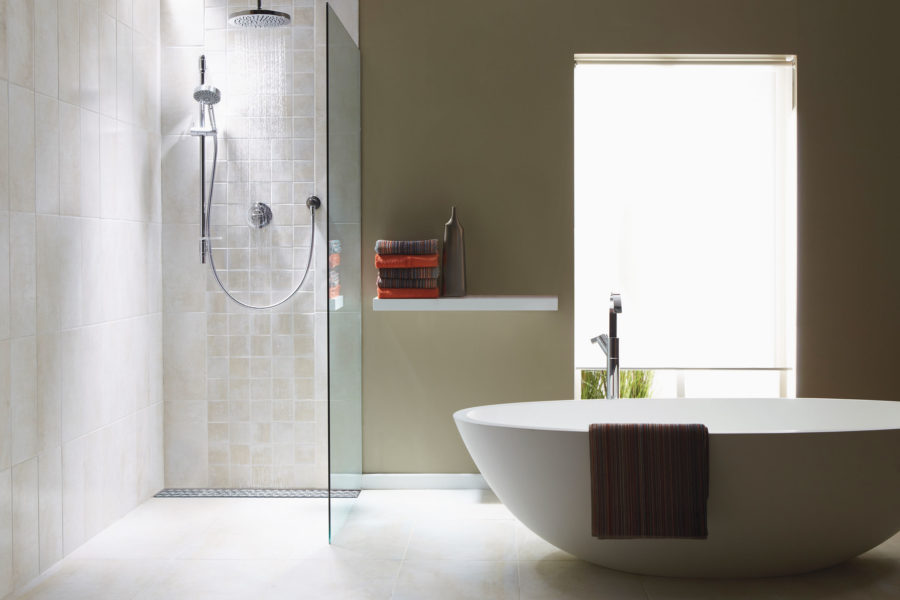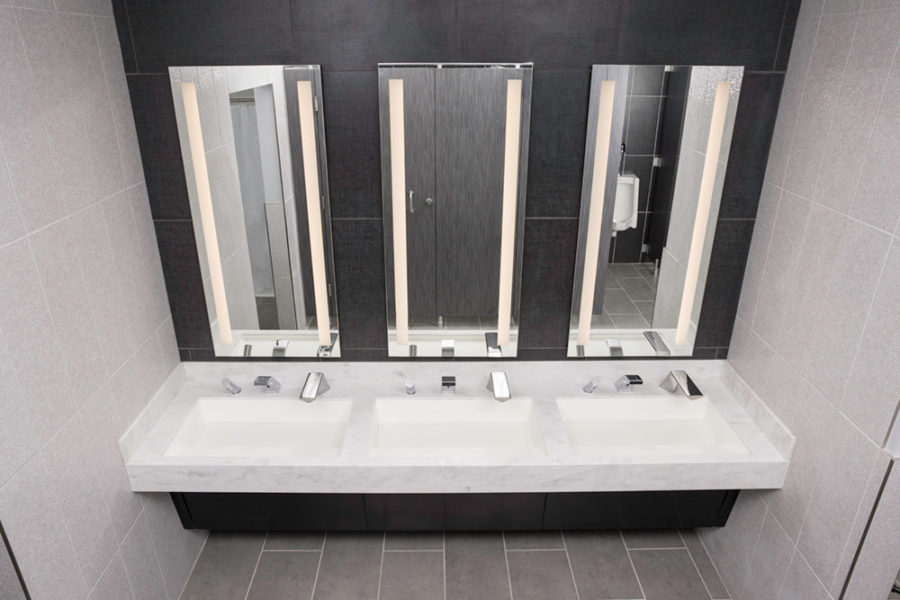Story at a glance:
- Public perception of the commercial restroom is getting a makeover, as occupants demand cleaner, more private spaces.
- Designers can save water in projects by choosing high-efficiency, water-saving toilets.
- Materials matter when it comes to sustainability—from the paint on the walls to the tile under your feet.
Sustainable bathroom design covers everything from what materials a designer specs to how occupants feel in the finished space. Are materials off-gassing? Are they easy to clean? And what about accessibility?
Designing more hygienic bathrooms is a top concern, especially post-Covid. We’ve talked to the experts in architecture, design, and manufacturing about trends they’re seeing as well as how to design more sustainable bathrooms.
Here are four steps to follow for more sustainable bathroom design, no matter the project.
1. Maximize water efficiency.

Photo courtesy of Niagara
Did you know the average American uses around 88 gallons of water per day per person? You probably did not, as the EPA reports most Americans underestimate how much water they use. It’s time to face the facts, though, considering an estimated 70% of all US counties may face water shortages by 2050, according to the NRDC.
The toilet you choose has an effect on the water used, too, says Niagara’s Jenni Steele. You can maximize water efficiency when you choose a vacuum-assist, ultra-high-efficiency toilet. A 0.8 GPF toilet can save up to 20,000 gallons of water per year. That’s enough to fill an 18-by-40 foot in-ground pool. GPF, or gallons per flush, is a measurement of how much water is used each time you flush. “Thanks to decades of innovation, the ultra-high-efficiency toilets on the market today are some of the best-performing toilets available,” Steele says.
2. Choose sustainable materials.

ASI’s Alpaco Collection, seen here, is ideal for the most aesthetically demanding applications. Photo courtesy of ASI
What makes a material truly sustainable? For starters, it should be free of Red List ingredients—those “worst in class” materials, chemicals, and elements defined by the International Living Future Institute as known to pose risks to human health and the greater ecosystem.
Sustainable materials should also be durable and easy to clean. More designers are choosing sustainable materials in the bathroom that are beautiful, too. Take porcelain tile, for example. Porcelain tile supports health and sustainability, as it’s nonporous; there’s no place for mold or other microbes to grow, says Don Haynes, environmental/sustainability manager for Florim USA. Porcelain tile also won’t need harsh chemicals for cleaning, and it’s often made of natural raw materials like clay, sand, and feldspar, Haynes says.
Doors are another area that can make a difference in the bathroom—and they also make a big first impression. “Restroom square footage itself may not generate revenue, but it surely accentuates the experience of the building, which in turn enhances revenue generation,” says Cyrus Boatwalla, head of global marketing and operations for ASI Group—the world’s leading manufacturer of commercial toilet partitions, washroom accessories, lockers, and visual display products.
No one wants to see the crack in a door, either. ASI offers an integrated privacy system for stainless steel or powder-coated metal partitions in the bathroom that eliminate the need for retrofitted components. That saves clients time and money, Boatwalla says. The integrated privacy components—built into the door during manufacturing—overlap the pilaster on the hinge and latch sides and allow the door to close flush with the pilaster, making sure all sightlines into the stall are blocked.
Another easy way to freshen up a space? Consider a coat of nontoxic paint.
3. Make it accessible.

Curbless shower. Photo courtesy of Oatey
Many building owners are focusing more on upgrading their properties, including adding spa-like and accessible amenities to modernize their places. One factor driving the trend toward more accessible and inclusive restrooms is the aging population, says Evan Novak, senior manager of commercial sales at Oatey Co. ADA accessible features like curbless showers and grab bars are in high demand these days, he says.
“Grab bars are in high demand for hospitals, hotels, government facilities, commercial buildings, and residential settings. Dearborn Grab Bars are ADA-compliant and available in 1¼-inch and 1½-inch diameters with concealed or open flanges,” Novak says. “Available in peened or satin finishes, these grab bars can be ordered in whatever desired length is needed.”
Curbless showers combined with QuickDrain are another ideal design solution, as they have no barrier to cross. The floor more easily accommodates a freestanding bench, wheelchair, or other mobility aids. The QuickDrain complete shower solution is an eco-friendly solution, too. To date, more than 19 million plastic bottles have been repurposed by the manufacturer into thousands of pre-sloped and tile-ready shower pan systems. Made of extruded rigid PET plastic foam, the lightweight and shatterproof shower pans and panels are constructed from 100% post-consumer plastic water bottles.
4. Keep it clean.

The D|13 sink system. Photo courtesy of D|13 Group
Easy to clean solutions are crucial in commercial environments where paper towels could easily overflow and, worse yet, patrons could slip and hurt themselves. The D|13 Sink System and Excel Dryer’s high-speed, energy-efficient XLERATORsync® hand dryer make public bathrooms more pleasant.
D|13 focuses on designing high-end commercial products for public restrooms that emphasize public safety and hygienic restroom environments. The D|13 Sink System combines the soap dispenser, water faucet, and hand dryer into a single, 30’-wide station so customers can wash and dry their hands in an efficient, left-to-right process in less than 30 seconds.
These solutions are also more energy-efficient. Hand dryers from Excel Dryer have been proven by a Life Cycle Assessment to have a lower carbon footprint over conventional hand dryers and paper towel systems (recycled and non-recycled). Furthermore, property managers dedicate far fewer maintenance resources when replacing and disposing of paper towel trash is removed from their checklist by a no-maintenance hand dryer.


